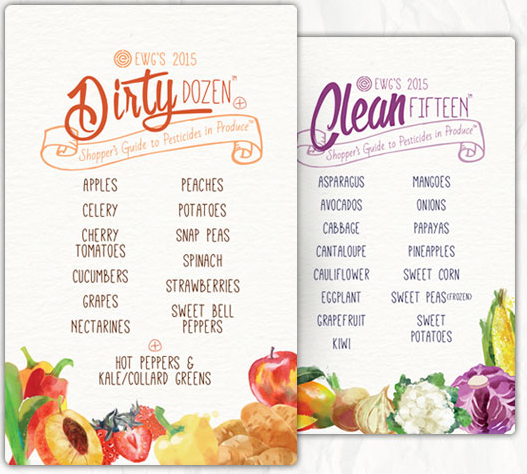If you’re anything like me, then you’ve likely had a moment when you’ve been stopped in your tracks in the produce section of the grocery store. The culprit? The sign next to the organic cucumbers that says $3.00, or the $7.00 strawberries. At that point I often wonder to myself, or aloud for that matter, how the same produce in the conventional aisle costs less than half of that amount.
So what is there to do? For me, I prioritize what to spend the extra money on. How do I do that? Great question! I use a list prepared by the Environmental Working Group called the “Clean 15” and “Dirty Dozen”. It basically breaks down which fruits and vegetables contain the least and most pesticides. It also takes into account how much of the pesticides are absorbed into the food.
For example, avocado is on the “Clean 15” list. This means that buying organic avocado is not something you need to prioritize. If you think about it, it makes sense. An avocado has a tough shell that gets removed before eating. Works for me.
Now think about strawberries. Strawberries grow very close to the ground and are sweet, attracting lots of bugs. They also don’t have a shell of any kind, which can make them more vulnerable. Hence, more pesticide usage. Strawberries are on the “dirty dozen” list.
Check out the full list above. The “Dirty Dozen” are the fruits and veggies with the most pesticides found on them, and the ones you want to buy organic. The “Clean 15” are the fruits and veggies that have the least amount of pesticide residue. These are the fruits and veggies that you don’t need to worry about buying organic. Some people like to post this list on their fridge or keep it stored on their phone for when they go to the grocery store.
Just remember, there is no need to get overwhelmed by this information. Eating vegetables is great, even conventionally grown vegetables. You can also wash and peel non-organic vegetables to remove some of the pesticides. Are organic better? Sure. But eating vegetables at all is a great thing for your body. If your budget allows for it, prioritize buying items off the “Dirty Dozen” list organic.
And, as a side note, dairy, eggs and meat should always be bought organic and, when possible, grass-fed or pasture raised.
Here are some of my budgeting secrets when buying organic:
- Sales, sales and more sales! Even Whole Foods has sales! I know I was super happy when Whole Foods was selling organic Swiss Chard for $1.50 per bunch.
- Trader Joes has really competitive prices on organic cucumbers, celery, kale and collards.
- Buy frozen. Frozen organic berries can be less expensive than the fresh ones (and better off season).
- Shop at Farmer’s Markets or at a local farm (yes, we have local farms in the city!) and ask questions. Sometimes farmers can’t afford to get the organic designation, but they don’t use pesticides or herbicides on their land. Smaller farms also often use less pesticides.
- Buy in bulk when you can and cook and freeze what you can’t eat.
Happy shopping!
*this post was originally posted on 5/26/14

